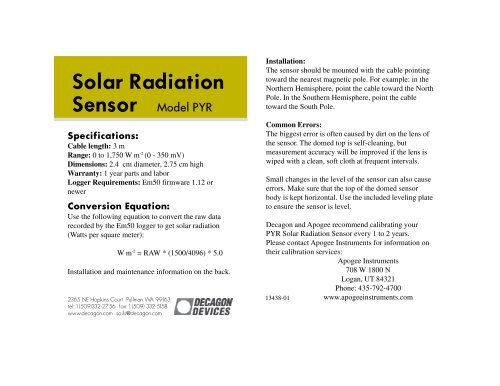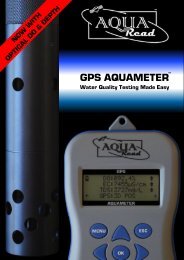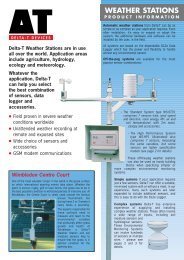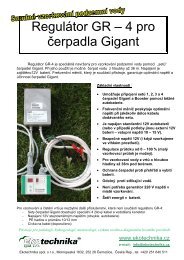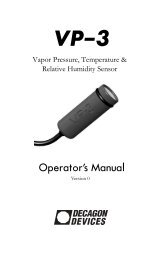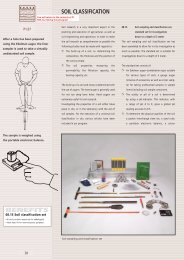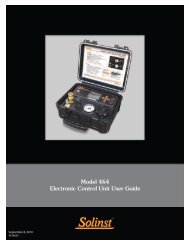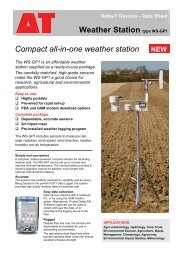WEB-Solar-Radiation-Sensor-Information-Sheet.pdf Solar Radiation ...
WEB-Solar-Radiation-Sensor-Information-Sheet.pdf Solar Radiation ...
WEB-Solar-Radiation-Sensor-Information-Sheet.pdf Solar Radiation ...
Create successful ePaper yourself
Turn your PDF publications into a flip-book with our unique Google optimized e-Paper software.
<strong>Solar</strong> <strong>Radiation</strong><br />
<strong>Sensor</strong> Model PYR<br />
Specifications:<br />
Cable length: 3 m<br />
Range: 0 to 1,750 W m -2 (0 - 350 mV)<br />
Dimensions: 2.4 cm diameter, 2.75 cm high<br />
Warranty: 1 year parts and labor<br />
Logger Requirements: Em50 firmware 1.12 or<br />
newer<br />
Conversion Equation:<br />
Use the following equation to convert the raw data<br />
recorded by the Em50 logger to get solar radiation<br />
(Watts per square meter):<br />
W m -2 = RAW * (1500/4096) * 5.0<br />
Installation and maintenance information on the back.<br />
2365 NE Hopkins Court Pullman WA 99163<br />
tel: 1 (509)332-2756 fax: 1 (509) 332-5158<br />
www.decagon.com soils@decagon.com<br />
Installation:<br />
The sensor should be mounted with the cable pointing<br />
toward the nearest magnetic pole. For example: in the<br />
Northern Hemisphere, point the cable toward the North<br />
Pole. In the Southern Hemisphere, point the cable<br />
toward the South Pole.<br />
Common Errors:<br />
The biggest error is often caused by dirt on the lens of<br />
the sensor. The domed top is self-cleaning, but<br />
measurement accuracy will be improved if the lens is<br />
wiped with a clean, soft cloth at frequent intervals.<br />
Small changes in the level of the sensor can also cause<br />
errors. Make sure that the top of the domed sensor<br />
body is kept horizontal. Use the included leveling plate<br />
to ensure the sensor is level.<br />
Decagon and Apogee recommend calibrating your<br />
PYR <strong>Solar</strong> <strong>Radiation</strong> <strong>Sensor</strong> every 1 to 2 years.<br />
Please contact Apogee Instruments for information on<br />
their calibration services:<br />
Apogee Instruments<br />
708 W 1800 N<br />
Logan, UT 84321<br />
Phone: 435-792-4700<br />
13438-01 www.apogeeinstruments.com
Installation:<br />
The sensor should be mounted with the cable pointing<br />
toward the nearest magnetic pole. For example: in the<br />
Northern Hemisphere, point the cable toward the North<br />
Pole. In the Southern Hemisphere, point the cable<br />
toward the South Pole.<br />
Common Errors:<br />
The biggest error is often caused by dirt on the lens of<br />
the sensor. The domed top is self-cleaning, but<br />
measurement accuracy will be improved if the lens is<br />
wiped with a clean, soft cloth at frequent intervals.<br />
Small changes in the level of the sensor can also cause<br />
errors. Make sure that the top of the domed sensor<br />
body is kept horizontal. Use the included leveling plate<br />
to ensure the sensor is level.<br />
Decagon and Apogee recommend calibrating your<br />
PYR <strong>Solar</strong> <strong>Radiation</strong> <strong>Sensor</strong> every 1 to 2 years.<br />
Please contact Apogee Instruments for information on<br />
their calibration services:<br />
Apogee Instruments<br />
708 W 1800 N<br />
Logan, UT 84321<br />
Phone: 435-792-4700<br />
13438-01 www.apogeeinstruments.com


